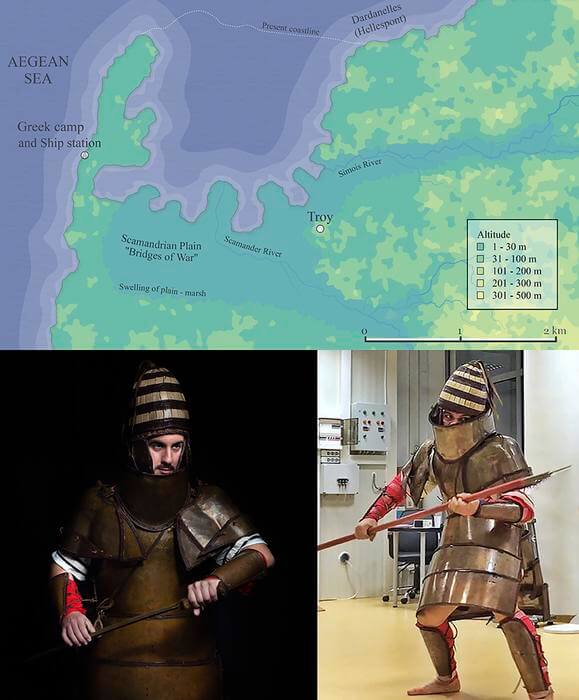VOLOS, Greece — An incredibly rare 3,500-year-old suit of Mycenaean bronze armor was more than just a ceremonial fashion statement in ancient times, an eye-opening experiment reveals. Thanks to a team of Greek Marines, researchers have discovered that this Bronze Age suit was actually meant for combat and lots of it!
The ancient centerpiece was an incredibly well-preserved bronze cuirass (a muscle armor covering the body) found in 1960 in a tomb near the village of Dendra, not far from the legendary citadel of Mycenae. Made up of two breastplates, a jacket-like pleated section, and other pieces weighing over 50 pounds in total, it’s one of the oldest and most complete examples of Bronze Age body armor ever discovered in Europe.
For decades, scholars have debated whether heavy suits like these were truly practical protection worn by warriors of the heroic age described by Homer and others or simply ornamental garments for the wealthy elite. After all, that’s a heck of a lot of weight to lug into battle.
The new University of Thessaly-led study, published in PLoS ONE, provides compelling evidence the armor was, in fact, fully functional and capable of battle. The key was an exhaustive 11-hour combat simulation carefully crafted from descriptions and scenes in the Iliad to recreate the activities and fighting styles used by high-ranking warriors over the course of a typical day during the Trojan War.
First, the researchers conducted meticulous textual analyses and reviews of the scholarly literature to extract details about the terrain, timing, nutrition, training, weapons, battle formations, and combat techniques from Homer’s account. They then had an elite team of Greek military personnel wear an accurate replica suit and perform the simulation’s intense regimen of marching, chariot maneuvering, martial combat sequences, and other strenuous activities.
“The armor that our volunteers wore was the same dimensions and similar weight to the Bronze Age original. We also monitored calorie intake based on a ‘Homeric diet’ (about 4,443 calories) derived from relevant descriptions found in the Iliad, and calorie expenditure together with the stresses placed on the volunteers’ bodies under temperatures typical for a Greek summer of 30-36 degrees Celsius. When the 11-hour battle protocol began we measured heart rate, oxygen consumption, core temperature, fluid loss, and muscular function,” explains Professor Andreas Flouris from the University of Thessaly in a media release.

Incredibly, the soldiers successfully endured the grueling recreation while clad in the 50-pound bronze panoply.
“We found that the armor allowed full flexibility of movement and did not exert excessive physiological stress on the body. This means that despite earlier views which classified it as only a ceremonial outfit, the armor could be worn for extended periods by fit individuals in battle.”
Researchers also found that there were no major impairments while wearing the armor, with their heart rates, core body temperatures, and other biomarkers all remaining within acceptable levels throughout. The Marines even managed to sneak in a few “breaks” for light snacks like bread, cheese, and wine, just as Homeric warriors would have done.
In another phase, the team created a computer simulator to model the thermodynamic impacts of different environmental conditions and battle intensities on a heavily-armored fighter. The results again affirmed the Dendra suit’s viability across a range of realistic scenarios.
So, while incredibly cumbersome, the defining feature of Mycenaean warfare appears to have been the incredible resilience, strength, and endurance of its elite armored warriors. The new study lends substantial weight to long-debated historical accounts of their ETAs (elite armored units, essentially) being capable of extended, highly mobile combat over many hours.
“Sixty years on from the discovery of the Dendra armor we now understand, despite its cumbersome appearance at first sight, that it is not only flexible enough to permit almost every movement of a warrior on foot but also resilient enough to protect the wearer from most blows,” Prof. Flouris concludes.
